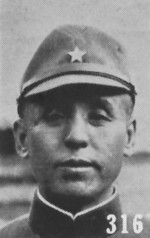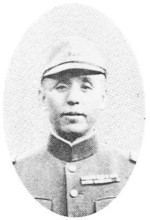Li Shouxin
| Surname | Li |
| Given Name | Shouxin |
| Born | 11 Jul 1872 |
| Died | 1 May 1970 |
| Country | China |
| Category | Military-Ground |
| Gender | Male |
Contributor: C. Peter Chen
ww2dbaseLi Shouxin was born into a Mongolian family in the Inner Mongolia region of Qing Dynasty China in 1872. In 1919, he enlisted in the local warlord forces of Rehe Province, China. In 1922, he joined the forces of warlord Zhang Zuolin, reaching command at the regiment level. Between 1929 and 1930, now under the command of Zhang Zuolin's son Zhang Xueliang, he led troops against the successful campaign against the rebel forces of Gada Meiren in northern China. In late 1931, he fought against the Japanese and was personally credited with the downing of one Japanese aircraft. Throughout 1932, he was courted by the Japanese, and in Feb 1933, as the deputy commander of the 17th Cavalry Brigade, he surrendered to the Japanese. Immediately employed by the Japanese, he commanded Japanese-sponsored Mongolian troops based in Rehe Province. He participated in continuous campaigns against Chinese positions in Suiyuan and Chahar Provinces in the next two years, latter part of that time under the banner of the Japanese-sponsored puppet state of Manchukuo. In Feb 1936, Demchugdongrub organized a Japanese-sponsored Mongolian nationalist movement, and recruited the support of Li, who was given the position of the deputy commanding officer of the fledging army. In May 1936, he was named the chief of the staff of the newly formed Mongolian Military Government. In Oct 1937, the puppet state of Mengjiang was established with Demchugdongrub as the head of state; Li was named the commander-in-chief of the army. In Jan 1940, he represented Mengjiang in a meeting at Qingdao, Shandong Province, China, during which he negotiated with representative Zhou Fuhai from the puppet government at Nanjing for a possible merger between the two states. In Jun 1941, the Chinese puppet government annexed the Mongolian puppet government, and Inner Mongolia was granted the status of an autonomous region; Li was named the Deputy Chairman of the region. After Japan was defeated in 1945, Chiang Kaishek pardoned his collaborationist past and employed him as the commanding general of Chinese 10th Route Army, which ultimately would be routed by Chinese Communist forces in 1947. He fled to Taiwan with the defeated Nationalist government in 1949, but before long he would return to Inner Mongolia to join with his former superior Demchugdongrub, who was planning a nationalist movement in Inner Mongolia. He evaded Communist arrest in 1950 by escaping to Mongolia, only to be caught and extradited in Sep 1950. He was found guilty of treason against China for collaborating with the Japanese and was imprisoned. He was pardoned in 1964. He worked at a history museum in Hohhot, Inner Mongolia, China for several years. He passed away from sickness in the same city in May 1970.
ww2dbaseSource: Wikipedia
Last Major Revision: Oct 2013
Photographs
 |  |  |
Li Shouxin Timeline
| 11 jul 1872 | Li Shouxin was born in the Inner Mongolia region of China. |
| 1 mai 1970 | Li Shouxin passed away in Hohhot, Inner Mongolia, China. |
Você gostou deste artigo ou achou este artigo útil? Se sim, considere nos apoiar no Patreon. Qualquer valor já vai ajudar! Obrigado. Por favor, ajude-nos a divulgar o site: Fique atualizado com WW2DB: |

» Battle of Suiyuan
» Battle of Chahar
- » 1,181 biografias
- » 337 eventos
- » 45,111 entradas na linha do tempo
- » 1,247 navios
- » 350 modelos de aeronaves
- » 207 modelos de veículos
- » 376 modelos de armas
- » 123 documentos históricos
- » 261 instalações
- » 470 eventos
- » 28,476 fotos
- » 365 mapas
Winston Churchill, on the RAF
Por favor, considere nos apoiar no Patreon. Mesmo R$1 por mês já faz uma grande diferença. Obrigado!
Ou, por favor, nos apoie adquirindo alguns produtos do WW2DB na TeeSpring. Obrigado!